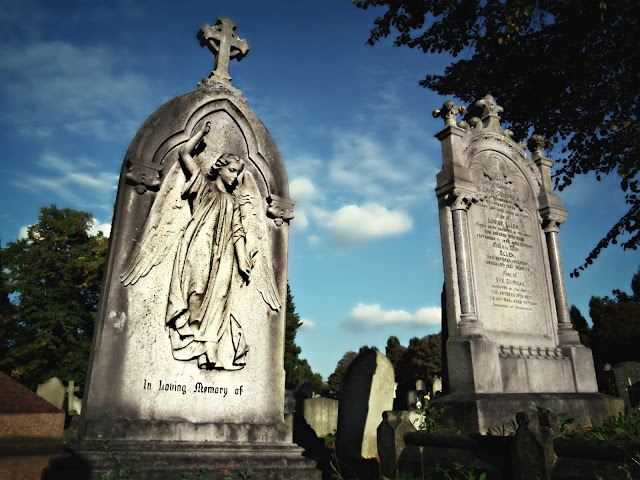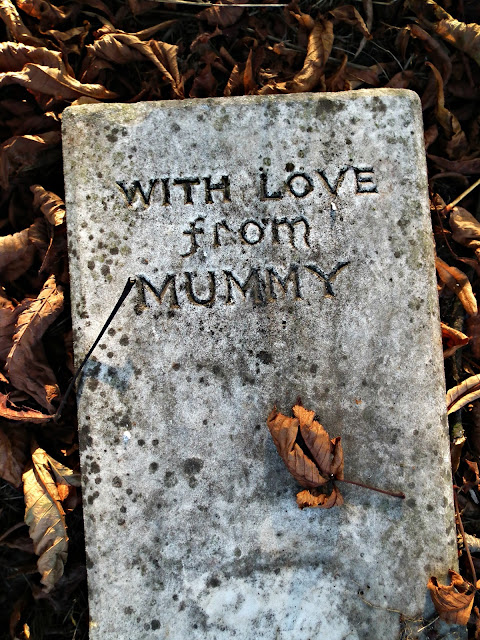A
New Cemetery for Willesden Dr Hoffmann, from the Home-office, attended
at the Willesden Vestry-hall yesterday for the purpose of hearing objections to
an application made by the Willesden Burial Board 'for permission to purchase
upwards of 20 acres of ground near the Jews' Cemetery, for the parish of
Willesden. Most of the members of the Burial Board were present besides members
of the Local Board. Mr Tilley, solicitor, in making the application, quoted
figures to show the necessity for a new burial ground, the population of the
parish having nearly doubled itself since 1881 when it was 27,000. There being
no opposition Dr. Hoffmann said he would recommend the granting of the
application.
Morning Post -
Tuesday 14 August 1888
The
26 acre Willesden New Cemetery opened in 1891 boasting a pair of ‘Pont Street
Dutch’ chapels. At the stone laying ceremony so beloved of local worthies in
the late nineteenth and early twentieth centuries members of the Burial Board
witnessed a scroll bearing their names and a copy of the previous days
newspaper placed into bottles and buried beneath the foundation stones of the
chapels. They then retired to a marquee to drink a number of toasts proposed by
Mr F.A. Wood, a local antiquary who was standing in for the absent vicar. Mr
Wood was, he said, not sure how to propose the toasts as “’success to the
cemetery’ would look like as though he wanted the cemetery filled as soon as
possible.” The Burial Board spent £20,000 on setting up the cemetery including
the cost of the land and of building the chapels (these were demolished in
1986). According to Hugh Meller in ‘London Cemeteries’ over 80,000 burials have
taken place and “in an attempt to create room for further burials, graves now
fill one of the main paths which resemble a marble traffic jam. As an
alternative solution, towards the back of the cemetery earth has been piled up
to provide space for yet more.” In this crammed space the council still insists
on using mechanical diggers to excavate new graves, much to the outrage of
cemetery users:
A grieving son
has slammed Brent Council, claiming they have showed disregard for the dead by
employing digger truck drivers who are desecrating graves in a cemetery.
Maxwell Glengall has told the [Kilburn] Times that the trucks are continuously
driven around and over graves in Willesden New Cemetery as they try to dig new
spaces. But he says they are carelessly knocking off parts of headstones and
even driving over graves, due to overcrowding…. Mr Glengall, whose mother has
been buried in the cemetery since July 2012, added that he was also concerned
at the dirt tracks being left by the diggers which have made much of the area
inaccessible…..“I’m very worried that my mother’s grave is going to be badly
treated and worry about those people who have gone to visit their loved ones
and found damage to their graves. How must they feel? Is this how council
cemeteries are run? I thought it was at least 100 years before a site was
retired for re-use. How can it have gone so far downhill?” A spokesman for Brent Council said they
“sincerely regretted any upset” but that they were similar to all other
councils in using diggers to excavate graves. He added that it was “a much
safer option for staff” and saved time.” (Kilburn Times, March 2013)
Other
notable events in the cemeteries history include the funeral of the Australian
cricketer Albert Edward Trott in August 1914 who at the age of 41 shot himself
at his lodgings in Denbigh Road, Harlesden. Trott is supposedly the only
batsman to have hit a ball over the Lords Pavilion during a match. Like his
older brother Harry, who captained Australia in the 1896 test tour, Albert
suffered from mental illness. At his inquest his landlady, with whom he had
lodged for two and a half years, testified that on the day of his death he had
sent for a sleeping draught to a local chemist as he had not slept all night
but the chemist refused to serve it. She had heard a noise from his room and
when she went to investigate found him lying on his back with a bullet wound in
his right temple and a revolver in his hand. On a scrap of paper he had written
a last will and testament; ‘Drawers and wardrobe to Mrs - , photos and drawers
for Mrs— Clark Street, Victoria, Australia.' The MCC paid for his funeral.
According
the newspapers there were wild scenes at the funeral of Mrs Ada Petchey and her
2 year old daughter when a crowd of nearly 500 women turned up baying for the
blood of Mr Petchey the deceased’s husband. The two women had died from gas
poisoning at their lodgings and at the inquest it was revealed that Mr Petchey
had left his wife and child without money after a quarrel and hadn’t returned
home until he read of their deaths in the papers. An hour before the funeral
crowds began to gather at the top of Tubbs Road in Willesden where the funeral
cortege was due to start its journey to the cemetery. A crowd gathered around
the mourning coach trying to get hold of Mr Petchey who had to be protected by
the police and the undertaker’s men. A large crowd of women booed and hissed as
the cortege got under way and at the cemetery Mr Petchey was barracked and
verbally abused by a seething mass of incensed women who, unable to get at him
because of a cordon of police officers, resorted to hurling clods of earth at
him as he tried to get away.
Willesden
was the burial place of Elsie Cameron in January 1925. Elsie had been murdered
by her lover Norman Thorne at Crowborough in Surrey in what the newspapers
dubbed the chicken run murder. Thorne was a Sunday school teacher from Kensal
Green who met typist Elsie in 1917. When he lost his job as an engineer he used
his savings to set up as a poultry farmer in Crowborough. He tried to break his
romantic entanglement with the older Elsie several times but without success.
When she claimed to be pregnant he snapped and apparently strangled her. His
version of the story was that she had hung herself. He claimed that he had
panicked and decided to get rid of her body by dismembering it with a hacksaw
and burying it on the farm. Not surprisingly the jury did not believe him.
Elsie was buried on Monday 26 January with large crowds gathering at the
cemetery to see the funeral. Cemetery officials locked the gates to prevent
access to the private funeral and so the curious stood twelve deep outside the
Wesleyan Chapel and lined the road into the cemetery. Amongst the floral
tributes were a wreath from Thorne’s parents and another which seemed to be
from the murderer himself, “Till we meet again, Norman” being the message on
the card. Elsie did not rest long in her rave, four weeks later in what one
newspaper called a “weird scene” she was exhumed. The exhumation began shortly
before midnight under the strictest secrecy, in a sharp wind on a bitterly cold
and frosty night. It took several hours to dig out the freezing grave and the
coffin was not opened until first light. The exhumation had been carried out at
the request of Thorne’s legal representatives. As well as Scotland Yard and the
accused’s pathologist, Sir Bernard Spilsbury, England’s most famous forensic
pathologist was also present. He gave evidence for the crown at Thornes trial.
The poultry famer was hanged at Wandsworth prison in April that year, still
protesting his innocence.





No comments:
Post a Comment